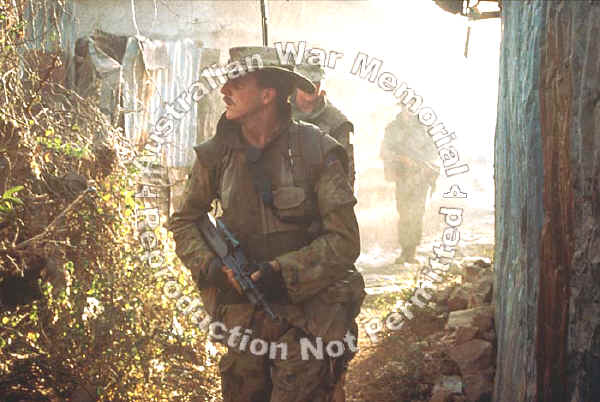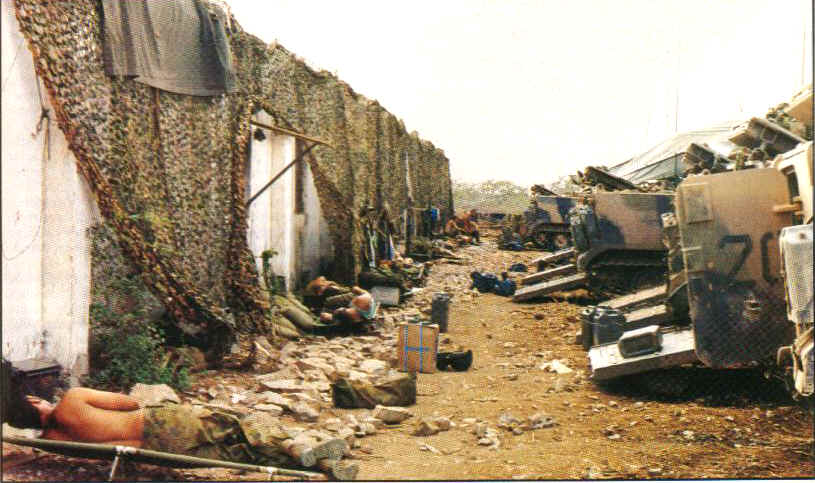It's
hard not to be impressed when you watch man and machine operating as
one smooth unit. Like something out of Apocalypse Now, four Black
Hawks materialize on the horizon until their dragonfly-like
appearance is joined by the signature thump of helicopter rotor
blades. Once landed, the infantrymen exit on cue, buffeted by the
downward thrust of swirling blades. No sooner have the 'grunts'
adopted firing positions and the four machines rise from the grass of
High Range Training Area near Townsville and blend back into the
horizon.
What
these diggers are doing is training for war. Should these 1st
Battalion the Royal Australian Regiment (1 RAR) soldiers ever have to
put this training into practice their response will be instinctive.
Just over 12 months ago, these same soldiers were patrolling the dusty
Somali streets of Baidoa. One of the big lessons to come out that
deployment is there aren't too many big lessons to learn.
 |
| Baidoa, Somalia. 1993-03-22.
Corporal T. R. Connor, in front, middle Pte Burger, and
Lieutenant Bob Worswick, at rear, members of 2 Platoon, A
Company, 1st Battalion, The Royal Australian Regiment (1RAR), on
foot patrol through a narrow overgrown lane in the native
quarter. They are serving with the Australian contingent to the
Unified Task Force in Somalia (UNITAF).
Note the Slouch Hat going back to war. |
Logistic
problems aside (more than one reliable source described the actual
deployment of the battalion group as messy), our training doctrine for
low-level conflict is sound. With minor adjustments in Somalia the
intensive patrolling at section level made way for the distribution of
humanitarian relief in the Australian sector.
"Nothing
could go on in that city without us knowing about it" says
Private Manvell Newton a section machine-gunner in Somalia. The
reason things improved in our area of operations was because we
absolutely saturated Baidoa in patrols. We patrolled 24 hours a day
seven days a week and every hour of the day we had a patrol in that
town - or three patrols - Baidoa was broken up into three areas and
there were always patrols in those areas."
The
intensity of the patrolling was remarked upon by practically everyone.
In the initial stages, there was little time for rest. An official
report states that had there been lesser sub-units available,
flexibility and capability would have been severely curtailed. Defence
artist, George Gittoes, also commented on the extreme conditions in
which the Australians worked on his return from Somalia.
 |
| Diggers trying to
catch 40 winks before the next patrol. It sure as hell ain't
like Nanna's place but it's home for the time being. |
Because
of the level of patrolling, contacts with bandits were frequent and
fast, with little time for hesitation. Under these circumstances the
instinctive spontaneity of military training came to the fore.
Pte
Newton's section had two contacts early on. While the bandits usually
fled, a quick response from sections was crucial for safety. While
fighting in an urban environment posed some problems, as Pte Newton
found out, the contact drills worked well.
"In
our first real contact, a Somali walked up behind one of our guys and
went to shoot him in the back of the head. A guy in our platoon saw it
and shot the Somali. There was a bit of confusion as to what was going
on - we were in the streets and we didn't know where the shots
were coming from.
"The
[Australian] guy that fired the shot was yelling that the Somali had
bolted. We later found out that another Somali had picked up the
pistol and ran down the road."
Pte
Newton's section was tasked to chase after the bandit. Not having seen
the actual incident, the section didn't know who they were looking for
but took off down the road. Pie Newton says rather than run around
something that would take him into the street he "just barreled
through it".
"There
was this bit of a fence coming out and I didn't want to run out into
the fire lanes so I decided to run through the fence - they were
usually made from little sticks about the size of your finger. What I
didn't realize was there was a 1ft thick log behind it and I went to
plough through it and bounced off it instead."
Unable
to find the bandit, the platoon settled into fire positions and
assumed the contact was finished. 1st Section then swept the area in a
dry assault. When the bandits saw the section coming, they fired. The
section returned fire and the bandits bolted.
"They
[the bandits] ran through this camel herd and they were straight in
front of us" says Pte Newton. "Baker (the section second in
command) yelled out a target indication he heard from the boss and it
was these two [running through the herd], so everyone started firing.
"I
started firing at the last guy and he was hoofing it, he was moving
pretty fast. At the time I was so high on adrenalin I wasn't watching
where my rounds were going and I couldn't see the tracer so I walked
the gun on to see the dust trail and walked the rounds onto the last
guy and he dropped."
-
The
success of the operations effectively ended the bandits' hold on
Baidoa. The Australian presence allowed non-government aid
organisations (NG0s) to deliver food relief in safety. During the
deployment, the battalion group escorted over 400 convoys and
delivered in excess of 8000 tonnes of grain to more than 137 villages
within the Australian sector.
Come
the time to go home, the NG0s did not want the Australians to leave.
Senior UN commanders also expressed regret at the battalion group's
departure. This is hardly surprising. Baidoa would not endear itself
to most Western hearts. Under control of banditry it was even worse.
The legacy of that banditry is everywhere.
An
independent observer on return from Somalia remarked of the irony of
keeping peace in a place too used to violence.
Lance
Corporal David Williams, B Squadron 3rd/4th Cavalry Regiment,
remembers Somalia as hot, dry and smelly. It wasn't the best place on
earth, that is for sure. A lot of starving kids, a lot of starving
people.
"Not
actually in Baidoa, that was probably one of the better places. When
you got into the outlying regions - 50km outside of Baidoa, then it
became very noticeable. Some of the little children had hospital
bands, like UNICEF was helping them out. There were some cases like
stick insects - they really were bad."
The
Townsville-based squadron mainly escorted convoys, such as food
distribution. By late March, however, the armoured personnel carriers
(APCs) were escorting individual NGO workers. LCpl Williams says APCs
also carried platoons to outlying regions to search for weapon caches
and "bad guys".
"It
was pretty disheartening at the start, how people could feud among
themselves and get themselves into such a predicament - but in
the end we saw we were doing good and the amount of food we
distributed and the way people reacted to the Australians in
particular.
Life
in Baidoa quickly settled into routine. LCpl Williams also was
impressed with the Australian approach to getting things done. Like
most of the Australians, he found the old saying of operations being
90 per cent boredom was well founded but sometimes there "was
quite an adrenalin rush".
"Another
call sign [another APC] and myself had just been to a CARE compound
about 3am where guards had stolen 50,000,000 Somali Shilling. All of a
sudden we heard this firefight in town about 2 or 3km away. We heard
the contact report over the radio and I rang up and asked if they
needed assistance."
He
says it took about five minutes to get to where the section was
ambushed, though they didn't know by who. The APCs dropped their
ramps, collected the infantry and quickly left the area. Later in the
morning, the two APCs were contacted again when they took AK47
fire in the town.
Now
12 months on, LCpl Williams says it is the sights and sounds of Baidoa
that linger on in his memory of the deployment.
They
don't have a sewerage system or anything like that. There are carcasses
of dead animals lying about and shallow graves all around the place.
Baidoa is on top of an escarpment and you go down into the bush and
there are just masses of shallow graves. That is probably one of the
biggest things that sticks in my mind."
While
the relief effort progressed smoothly, there were hiccups. Deploying
at Christmas made things more difficult than normal. Virtually the
whole Townsville-based brigade was on leave. As 1RAR operations
officer, Major Mark Fairleigh, states: "It is 'the' worst time to
deploy a battalion overseas".
Intelligence
on the situation in Baidoa was scant. Information wasn't available
through official channels. Before deployment, information was gleaned
from non-defence people such as Phoebe Fraser, daughter of the
former Prime Minister, Malcolm Fraser. The Commanding Officer 1RAR, Lieutenant Colonel
David Hurley, got more information from a former ADF member in Baidoa
by satellite telephone.
Equipment
problems also occurred. Sorting out what to take and what to leave at
home caused some heartache. In Baidoa, the Australians used US fuel to
run equipment. Generators, for instance, had timing trouble until the
machines seemingly adapted to the petrol.
Operationally,
there were some problems working in an urban environment, as Pte
Newton found out. Maj Fairleigh says we were not "well practiced"
in urban patrolling. Something, he believes, more attention at home
could rectify. He added that hopefully the army would devote more time
to this sort of low level training with some sort of facility and
increased training time.
Getting
enough specialist equipment was another problem. Global positioning
system (GPS) and night-vision equipment was used to advantage in
Somalia - but some say there wasn't enough.
Corporal Bill
Perkins, a section commander, says categorically: "We need more
night‑vision gear - the section needs more than one pair
of night-vision goggles". Given that Cpl Perkins' section
was ambushed twice at night you can understand his concern.
Other
problems that couldn't be expected cropped up as well. The reality of
searching vehicles turned out to be much different from training. In
Baidoa, a bus crammed with 90 people would turn up at a roadblock and
would need to be searched a far cry from sterile exercises back home.
Cpl Perkins says you had the problem where a truck full of bananas
might come along.
"You
just haven't got the time to take everything out. You could do it but
it would take you all day, so you just had to do the best you
could."
By
and large, however, Cpl Perkins agrees the foundation of training in
low-level operations met the demands of the situation, as
physically and mentally taxing as they were.